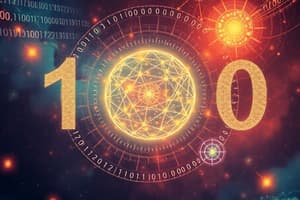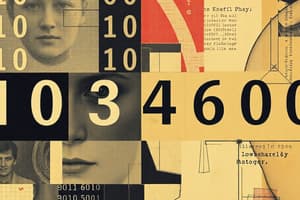Podcast
Questions and Answers
What is a number system?
What is a number system?
A representation of numbers using digits or symbols in a consistent manner.
Which of the following is not a main type of number system?
Which of the following is not a main type of number system?
- Triangular number system (Base - 3) (correct)
- Octal number system (Base - 8)
- Binary number system (Base - 2)
- Decimal number system (Base - 10)
How many digits does the octal number system use?
How many digits does the octal number system use?
Eight digits: 0, 1, 2, 3, 4, 5, 6, 7.
What digits are used in the decimal number system?
What digits are used in the decimal number system?
What is the base of the binary number system?
What is the base of the binary number system?
Convert (100111)₂ into the decimal system.
Convert (100111)₂ into the decimal system.
Convert (111111)₂ into the decimal system.
Convert (111111)₂ into the decimal system.
What is the first step in converting from decimal to binary?
What is the first step in converting from decimal to binary?
What are the results of dividing 17 by 2 multiple times in the conversion process?
What are the results of dividing 17 by 2 multiple times in the conversion process?
Which of the following is a rule for binary addition?
Which of the following is a rule for binary addition?
Flashcards are hidden until you start studying
Study Notes
Number Systems
- A number system represents numbers using digits or symbols consistently.
- The value of a digit is determined by its position and the base of the number system.
- Number systems facilitate conversions between different representations.
Types of Number Systems
- Binary: Base 2, uses digits 0 and 1.
- Octal: Base 8, uses digits 0-7. Advantage: fewer digits than other systems, reducing computational errors.
- Decimal: Base 10, uses digits 0-9. This is the system we typically use in everyday life.
- Hexadecimal: Base 16, uses digits 0-9 and A-F.
Converting Binary to Decimal
- Step 1: Determine the base of the given binary number, which is always 2.
- Step 2: Multiply each digit of the binary number by the appropriate power of 2, starting from the rightmost digit with 2^0 and increasing by 1 for each subsequent digit to the left.
- Step 3: Add the products calculated in step 2 to obtain the decimal equivalent.
- Example:* (100111)₂
- (1 x 2⁵) + (0 x 2⁴) + (0 x 2³) + (1 x 2²) + (1 x 2¹) + (1 x 2⁰)
- (1 x 32) + (0 x 16) + (0 x 8) + (1 x 4) + (1 x 2) + (1 x 1)
- 32 + 0 + 0 + 4 + 2 + 1 = 39
- Therefore, (100111)₂ is equal to (39)₁₀.
Converting Decimal to Binary
- Step 1: Determine the base of the required binary number, which is always 2.
- Step 2: Divide the given decimal number by the base (2).
- Step 3: Record the quotient and remainder.
- Step 4: Repeat steps 2 and 3 using the quotient as the new dividend until the quotient becomes less than the base (2).
- Step 5: The remainders, read from bottom to top, form the binary representation of the decimal number.
- Example:* Convert (17)₁₀ to binary.
- 17 / 2 = 8 remainder 1
- 8 / 2 = 4 remainder 0
- 4 / 2 = 2 remainder 0
- 2 / 2 = 1 remainder 0
- 1 / 2 = 0 remainder 1
- Reading the remainders from bottom to top, the binary equivalent is (10001)₂.
Binary Addition
- Binary addition is the foundation for binary subtraction, multiplication, and division.
- There are four basic rules for adding binary digits:
- 0 + 0 = 0
- 0 + 1 = 1
- 1 + 0 = 1
- 1 + 1 = 0 (with a carry-over of 1 to the next digit)
Studying That Suits You
Use AI to generate personalized quizzes and flashcards to suit your learning preferences.





